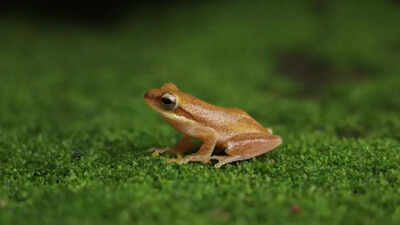New frog species found in Bastar, taking total count in region to 21 | Raipur News

RAIPUR: With the discovery of a small frog (measuring 27 millimetres) along with three other frog species, the Bastar region now boasts a total of 21 frog species.
Earlier, 17 species had been reported by Dr. Sushil Dutta, Head of the Department of Zoology at Government PG College, Jagdalpur. Chirixalus simus, also known as the Assam Pygmy Frog, is primarily found in Assam, Mizoram, Tripura, West Bengal, Bangladesh, and Bhutan.
The reporting of the Assam Pygmy Frog in Kanger Valley National Park and the Machhkot forest range highlights the rich and healthy flora of Bastar, said Dr. Dutta.
During their research survey in Kanger Valley National Park, Dr. Pratyush Mahapatra, scientist at the Zoological Survey of India, and Dr. Dutta reported the presence of 21 frog species.
A detailed report, along with photographs, has been published in a book released by the Chhattisgarh Biodiversity Board.
Chirixalus simus, or the Assam Pygmy Frog, is a tree-dwelling species that reproduces in water by laying eggs on plant leaves and twigs. The eggs are enclosed in a frothy layer to retain moisture until they hatch, explained Dr. Dutta.
The male frog is known for its distinct mating call that sounds like “chrik chrik.”
Minervarya kalinga, continuously spotted since 2010, reproduces during the winter and has now been reported as a new species.
Other species reported include Minervarya pierrei, Uperodon variegatus, Microhyla nilphamariensis, and Microhyla rubra, he said.
Dr. Mahapatra emphasized that species identification involves more than just collecting photographs; proper samples must be collected for taxonomic studies. Molecular-level research, including DNA testing, is crucial for differentiating morphologically similar species that may vary genetically. The nomenclature is adjusted accordingly, he added. He further stated that a more in-depth survey would be conducted in the future to expand this study.
Dr. Dutta noted that the considerable number of new findings underscores how richly nourished Bastar’s flora is. He pointed out that the faunal characteristics of Bastar resemble those of the Eastern and Western Ghats, as well as India’s northeastern region.
He expressed hope for continued support from the Kanger Valley National Park administration and the Chhattisgarh Forest Department for future studies.






